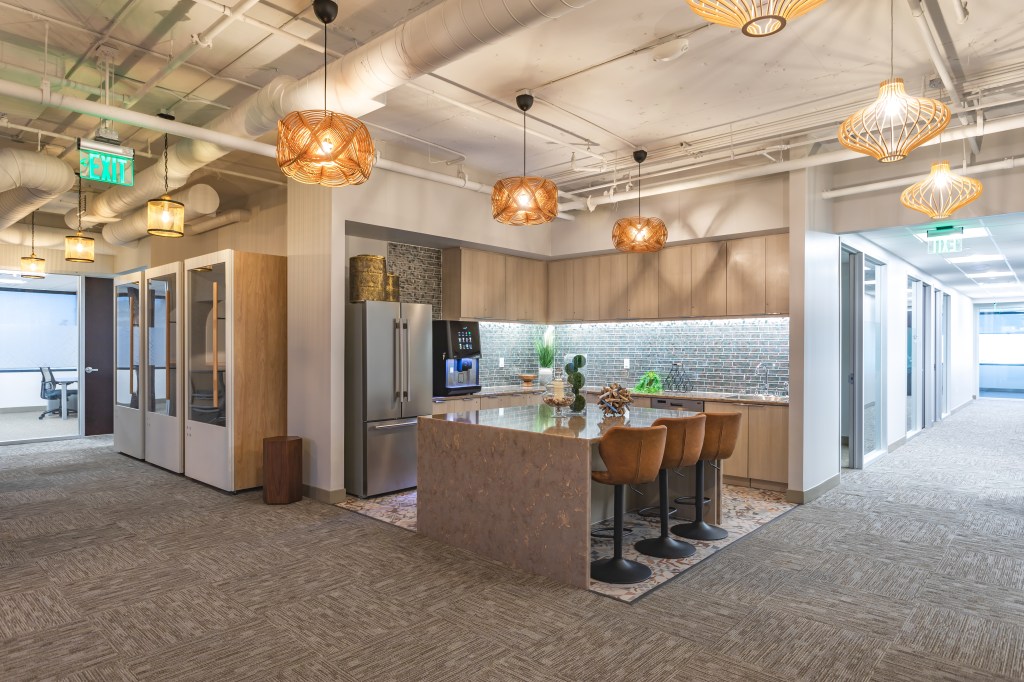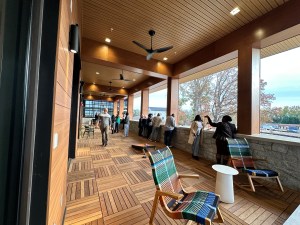Coworking Trends to Keep an Eye On in 2024
What’s ahead for the coworking sector? Find out in the last installment of our outlook series.

The coworking sector continues to show resilience, swiftly adapting to tenants’ constantly changing needs and wants. With growth mainly fueled by the pandemic-induced rise in hybrid work, coworking providers are now taking workspaces to the next level, banking on the ever-increasing demand for flexible and collaborative spaces.
“The pandemic has changed work, and while some executives may be insisting on a return to office, they know remote work isn’t going away,” said THRIVE | Coworking Chief Revenue Officer Chris Smith.
Over the past few years, operators have been actively remodeling the fundamental characteristics of workspaces as we know them in the traditional office sector. Coworking is no longer just a space where people work remotely. It is now part of the flexibility and agility movement that the modern worker expects. And office owners are finding ways to cope with this shift by adding flex space to their offerings.
READ ALSO: As Hybrid Work Expands, Coworking Is No Longer the Exception
“Traditionally, building owners have used incentives such as free rent, tenant-improvement allowance and expansion or contraction options to entice tenants when necessary,” said CBRE Global Head of Occupier Thought Leadership Julie Whelan. “Now flex space is a factor in that equation. Building owners can offer access to on-demand space during peak office attendance times, free hours of shared meeting space in the building, or bundling a long-term lease with a short-term suite requirement. Thus, flex office and meeting space offerings are part of the building amenitization,” she added.
According to a CBRE report on flex space demand and the company’s Spring 2023 U.S. Office Occupier Sentiment Survey, most investors are adding flexible spaces to their portfolios to reduce capital expenditures, offer collaboration space on demand and enter new markets. The biggest challenge here is creating a winning formula for all the parties involved: the landlord, the tenant and the flexible space provider.
Where coworking comes into play: trends and dynamics

As industry players navigate through the shifts in traditional office spaces, coworking is seen as a viable investment alternative because it offers exactly what today’s tenants and office users want: adaptable facilities that encourage teamwork, flexible scheduling and a better work-life dynamic.
As more businesses permanently adopt a combination of in-office and remote work, hybrid models play a critical role in coworking’s overall growth.
“Overall, demand for coworking is solid across a range of occupier types as companies adjust their real estate strategies to better manage hybrid working patterns,” Whelan noted. “Occupier strategies often include a portion of space dedicated to coworking—especially for requirements of 50 desks or fewer.”
Peter Kolaczynski, associate director at CommercialEdge, believes that cost savings are the main factor driving demand for coworking space nowadays. Additionally, with more vacant space in office buildings, an increasing number of landlords are embracing management-style agreements with operators.

Meanwhile, new approaches to coworking are also gaining traction. Quest Workspaces is now offering short-term rentals by month or by week, but the company’s packages also include on-demand services by hour. CEO Laura Kozelouzek told Commercial Property Executive that Quest provides a high-end experience combined with hospitality-centric services, which becomes a differentiator in the sector.
Other trends emerging in the sector are all access and pay-as-you-go solutions, according to Christelle Bron, CBRE’s Americas agile practice leader. “WeWork saw a 21 percent year-over-year increase in this product segment in 2023,” said Bron.
Another trend gaining momentum is coworking spaces in retail centers and apartment buildings, with the shared space model penetrating both industrial and retail fields for individual services, said Kolaczynski.
As for the layout of the spaces, many operators noticed an increased interest in private offices as opposed to mostly shared workspaces, with new company formation fueling the growth of smaller office layouts in coworking spaces.
“For a fraction of the cost of a traditional office, an entrepreneur can have their own space, personalize it however they like, and enjoy all the perks without the headaches and maintenance associated with leasing a standalone brick-and-mortar office,” Smith said.
What are the biggest challenges for coworking in 2024?
Although most operators view coworking as a hotspot in the industry, there are some challenges ahead in the sector, mainly originating from the ongoing economic uncertainty and the need to constantly adapt to tenants’ expectations. Finding the right balance between affordability, high-quality services, as well as partnering with the right investors, might also pose challenges going forward.
“I think the biggest challenge in the market today is the capital market environment which has led to more bank involvement in every deal we source” said John Wallace, CEO of Workbox, an operator with coworking locations across four states. “We utilize shared economic agreements which produce more cash flow variability than typical conventional leases, so we spend more time educating parties of the merit than in more normal markets.”
READ ALSO: Office Trends in 2024—How Much Will the Sector Change?
But despite the economic unpredictability, Smith believes that the low unemployment rate fueled by Gen Z and Millennials in the workforce will continue to drive demand for hybrid work settings, ultimately benefitting the coworking sector. Kozelouzek is even more optimistic, looking at the economic volatility as an environment that supports demand for coworking space due to more flexibility at minimal costs.
Rapid expansion

With the sector constantly growing, more companies are expanding their portfolios in markets where they’ve previously been active in, but don’t refrain from entering new areas either.
Established industry player Industrious opened its first Boston location in March of 2023. The company opened a 21,550-square-foot coworking space at a Harvard Square property owned by Carpenter & Co. Workbox also made its debut in Salt Lake City with a three-story location encompassing 19,972 square feet.
“We leverage our unique market segmentation to provide outsized value to our customer base and ultimately higher occupancy and revenue rates for our landlord partners,” said Wallace. “Our strategy focuses almost exclusively on takeovers of underperforming assets that would otherwise require heavy capital infusions to repurpose.”
In the past year, THRIVE | Coworking also grew its portfolio, adding five locations in five months, including a space in Gainesville, Fla., within a 1900-built historical building. The provider also added a new 21,450-square-foot coworking space in Greenville, S.C., to its footprint. As for 2024, the company plans to open a new location in Bozeman, Mont., and four new spaces in Winston-Salem and Chapel Hill, N.C., Duluth, Ga., as well as Birmingham, Ala. The provider caters to a wide range of industries, from lawyers and accountants, to marketers and realtors of all ages.

Despite coworking expanding to new markets, higher penetrated markets such as Miami; Nashville, Tenn.; Austin, Texas; and New York City, are still registering the highest demand. NYC leads the sector in terms of square footage, while Miami remains the most penetrated market. Quest Workspaces, for example, generated 30 percent growth in 2023 by expanding in South Florida and adding new locations in Miami-Dade County.
One thing that has shifted for sure in both traditional office space and coworking is the creativity around catering to tenants’ individual needs. Besides free drinks and snacks, it’s convenience that matters most to tenants, especially proximity to their homes and position in vibrant neighborhoods, according to Smith. Fostering a sense of community is also a priority for some companies.
“They like the ability to network and meet new people, and the monthly breakfasts, lunches and happy hours are a great way for the community to benefit from each other, leading to more resources and new business opportunities,” Smith added.
Most of Workbox’s tenants are companies between three and 50 employees, who benefit from strategic advising via experienced mentors and professionals, and have access to a range of potential investors.
And with the sector on an upward trajectory, coworking is also welcoming new operators. Comerica Bank, for example, launched a $3 million flex office initiative, planning to repurpose 10,000 square feet into flex spaces.
What’s next for coworking?
In the year ahead, Whelan believes that the sector will find more stable ground and that the newfound business models—such as the one in which landlords and providers collaborate more as opposed to providers leasing the space themselves—will fuel supply growth. She noted that the term “coworking” needs to be broadened, as nowadays it includes so much more than just on-demand, short-term space. Flexible office suites now encompass both standalone offerings, as well as services within a coworking space, with access to shared amenities.
“Most enterprise users have a limited need for true coworking space,” said Whelan. “They’re usually looking for flexible space that gives them a level of branding and privacy while also offering more flexibility than a traditional 7- to 10-year lease.”
READ ALSO: Why Coworking Is Catching On
Kozelouzek expects more commercial real estate landlords to add flex products to their buildings’ offerings, such as team workspaces and more meeting rooms.
“We are already seeing several operators take off within the retail community, specifically related to health and beauty,” she said. “With industrial vacancies still tight, I’m expecting the idea of meeting small business needs of blended office, shipping and distribution flex spaces under a shared space model to gain popularity.”
Though there are multiple uncertainties today, one thing is for sure: The “one-size-fits-all strategy” will no longer be effective as shared economic structures strengthen their position in the sector. Strategies that mirror the hotel sector, that push operators to better segment their customers and bring value to targeted subsets of the market, will have a favorable outcome going forward, Wallace expects.







You must be logged in to post a comment.